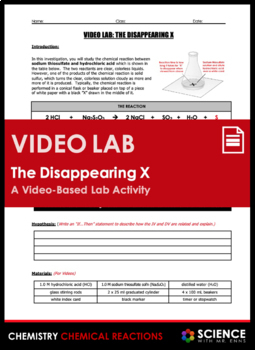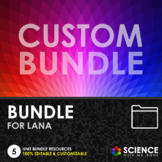Disappearing X or Cross Rate of Reaction Video Lab Activity Sodium Thiosulfate
- Zip
Also included in
- This unit bundle product contains 24 resources needed for a typical upper middle school and lower high school chemistry unit on chemical reactions. Topics include: physical and chemical changes, chemical equations, balancing equations, law of conservation of mass, types of chemical reactions, ratesPrice $61.40Original Price $76.75Save $15.35
- This is a custom bundle created for Suzanne. It is a collection of various class forms and resources, nature of science and chemistry products. Bundle Contents:NGSS Middle School Chemistry Curriculum - Full Course BundleSuper Bundle – Scientific Method & MetricsBundle - Class Forms, Notices, andPrice $258.02Original Price $368.10Save $110.08
- This is a custom bundle created for Lana. It is a collection of chemistry and physics unit bundles.Bundle Contents:UNIT BUNDLE - Forces and Newton's LawsUNIT BUNDLE - EnergyUNIT BUNDLE - Classification of MatterUNIT BUNDLE - Atoms and the Periodic TableUNIT BUNDLE - Chemical ReactionsWant Your Own CPrice $213.92Original Price $305.60Save $91.68
Description
This Disappearing Cross or Sodium Thiosulfate Virtual or Video Lab is a 4-page lab activity (with 8 pages of answer keys and teacher resources) designed to give upper middle-school or early high school students experience in measuring the rate of reaction between sodium thiosulfate and hydrochloric acid while changing the concentration. After conducting the experiment, students graph and explain their findings using ideas found in collision theory. Students conduct the lab by viewing videos of actual experimental trials - 20 in total. The activity can be done in class, online, or through hybrid learning. No lab equipment is required!
Overview of the Activity:
- In this lab, the 2 reactants are clear, colorless liquids, which are combined in a beaker or flask placed on top of a paper with a black ”X” drawn on it.
- As the 2 reactants combine, one product is sulfur, which turns the solution opaque as more is produced. Eventually, the black “X” disappears from view.
- This creates a simple chemical timing mechanism to determine the rate of the reaction.
- There are 5 videos in total, one for each concentration of sodium thiosulfate; each video contains 4 trials for a total of 20 trials
- This video lab is identical to the classroom version (described below) so that educators have the option of performing the lab in class, virtually, or a hybrid of the two, depending on their class needs!
NOTE: Lab Also Available as a Classroom Investigation:
- This video lab has an equivalent classroom-based version where students perform a basic serial dilution in order to investigate the effect of sodium thiosulfate concentration on the rate of reaction.
- The link to this product is found below:
- LAB - Disappearing X Sodium Thiosulfate Rate of Reaction - Classroom Lab
Product Contents:
Page 1 - The Disappearing X Reaction Introduction:
- Description of the chemical reaction and how the reaction rate is measured
- Description of how the video lab should be conducted by students
- Problem: "What is the effect of increasing the sodium thiosulfate concentration on the rate of reaction"
- Hypothesis: with space for students to write their own hypotheses
- Materials: lists materials used in the videos, but can also be used if students are to perform the experiment in a classroom
Page 2 - Pre-Lab Worksheet:
- Overview: description of how to perform a serial dilution to help students understand how the sodium thiosulfate solutions where created for the videos
- Dilution Table: students calculate the concentrations (as a %) for each solution
- Variables: students list the independent variable, dependent variables, and 3 relevant constants after reading over the procedure on Page 3
Pages 3-4 - Lab: Rate of Reaction vs. Thiosulfate Concentration:
- Procedure: this is listed to help students understand the experimental method
- Data table: to record reaction times from each of the video trials
- Graph: a blank graph grid (10x10) for creating a graph of experimental results
- Analysis: 3 questions that ask students to summarize their experimental results and explain their findings scientifically using ideas from collision theory
- Conclusion: 1 question that asks students to summarize their findings
Pages 5-8 - Answer Key:
- 4 pages of color-coded answer keys for all written sections
- Includes sample data from the videos if this needs to be shared with students
- Includes a sample graph based on sample video data
Pages 9-12: Teacher Guide and Download Link:
- Link to a Google Drive folder that includes a PDF version of the lab document for students and 2 folder sets of videos:
- High Definition (1080p) with higher resolution but larger file sizes
- Standard definition (720p) with lower resolution but smaller file sizes
- Overview of collision theory and the nature of concentration
- Suggested time frames and what to accomplish in each session/class
- Tips on how to share the videos with students as well as implementation tips based on Seller experience
Downloadable in 2 Formats:
- This product comes in 2 formats: a static PDF document and fully-editable WORD document
- Download the full PDF preview to see EXACTLY what you are getting!
Relevant NGSS Core Idea(s) Addressed by This Product:
NGSS - MS-PS1.A
Physical Science - Matter and its Interactions - Structure and Properties of Matter
NGSS - MS-PS1.B
Physical Science - Matter and its Interactions - Chemical Reactions
You Might Also Like the Following Unit Resources:
UNIT BUNDLE - Chemical Reactions
PPT - Jeopardy Game: Chemical Reactions Review
Unit Overview & Key Words - Chemical Reactions Unit
Activity - Physical & Chemical Properties & Changes Sorting Cards (2 Set Bundle)
Worksheet - Physical and Chemical Properties and Changes
Worksheet - What are Chemical Equations?
Worksheet - Balancing Chemical Equations (2 Worksheet Bundle)
Worksheet - What are the Types of Chemical Reactions?
Worksheet - Naming Compounds, Balancing Equations & Classifying Reactions
Worksheet - What is Collision Theory?
Lab - Mystery Powders - Physical and Chemical Properties of Matter
Lab - Ziploc Bag Physical and Chemical Changes
Lab - Signs of a Chemical Reaction
Lab - Great Steel Wools of Fire (A Conservation of Mass Investigation)
Lab - Double Displacement Reactions
Lab - Alka-Seltzer Rate of Reaction - Classroom Lab
Lab - Alka-Seltzer Rate of Reaction - Virtual Lab
Lab - Disappearing X Sodium Thiosulfate Rate of Reaction - Classroom Lab
Lab - Disappearing X Sodium Thiosulfate Rate of Reaction - Virtual Lab
Quiz - Balancing Chemical Equations (4 Quiz Bundle)
Quiz - Types of Chemical Reactions
Unit Review - Chemical Reactions
Unit Test - Chemical Reactions
Connect with More Science With Mr. Enns Resources:
Be sure to follow my TpT store by clicking on the Follow Me next to my seller picture to receive notifications of new products and upcoming sales.
Terms of Use:
Copyright © Douglas Enns. All rights reserved by author. This product is to be used by the original downloader only. Copying for more than one teacher, classroom, department, school, or school system is prohibited. This product may not be distributed or displayed digitally for public view. Failure to comply is a copyright infringement and a violation of the Digital Millennium Copyright Act (DMCA). Clipart and elements found in this document are copyrighted and cannot be extracted and used outside of this file without permission or license. Intended for classroom and personal use ONLY.








